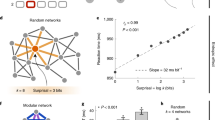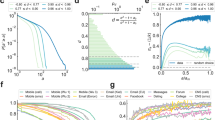These scientists prioritized their replies to letters in the same way that people rate their e-mails today.
Abstract
In an era when letters were the main means of exchanging scientific ideas and results, Charles Darwin (1809–82) and Albert Einstein (1879–1955) were notably prolific correspondents. But did their patterns of communication differ from those associated with the instant-access e-mail of modern times? Here we show that, although the means have changed, the communication dynamics have not: Darwin's and Einstein's patterns of correspondence and today's electronic exchanges follow the same scaling laws. However, the response times of their surface-mail communication is described by a different scaling exponent from e-mail communication, providing evidence for a new class of phenomena in human dynamics.
Similar content being viewed by others
Main
During their lifetimes, Darwin sent at least 7,591 letters and received 6,530; Einstein sent more than 14,500 and received more than 16,200. We start from a record containing the sender, recipient and the date of each letter1,2 sent or received by the two scientists. Their correspondence exploded after their rise to fame, and reached a highly fluctuating pattern afterwards (Fig. 1a). Although, on average, they wrote 0.59 (Darwin) and 1.02 (Einstein) letters a day during the last 30 years of their lives, these averages hide significant daily fluctuations. For example, Darwin wrote 12 letters on New Year's Day in 1874 and Einstein received 120 letters on 14 March 1949, his 70th birthday.
a, Historical record of the number of letters sent (Darwin, black; Einstein, green) and received (Darwin, red; Einstein, blue) each year by the two scientists1,2. An anomalous drop in Einstein's correspondence marks the Second World War period (1939–45, boxed). Arrows, birth dates of Darwin (left) and Einstein (right). b, c, Distribution of response times to letters by Darwin and Einstein, respectively. Note that both distributions are well approximated with a power-law tail that has an exponent α=3/2, the best fit over the whole data for Darwin giving α=1.45±0.1 and for Einstein α=1.47±0.1.
The response time, τ, represents the time interval between the date a letter was received and the date that the reply was sent. As shown in Fig. 1b,c, the probability that a letter will be replied to in τ days is well approximated by a power law, P(τ)≈τ−α, where α=3/2. The fact that the scaling spans close to four orders of magnitude, from days to years, indicates that most responses (53% for Einstein, 63% for Darwin) were sent within less than ten days.
In some cases, however, the correspondence was stalled for months or years. Some of these represent long breaks in the correspondence and a few are a consequence of missing letters. Others, however, correspond to genuine delays, like Einstein's response on 14 October 1921 to Ralph De Laer Kronig's letter of 26 September 1920, which starts with: “In the course of eating myself through a mountain of correspondence I find your interesting letter from September of last year.”
To understand the origin of the observed scaling behaviour, we have to realize that, given the wide range of response times, both Darwin and Einstein must have prioritized correspondence in need of a response. Thus, a simple model of their correspondence assumes that letters arrive at a rate λ and are answered at a rate µ. Each letter is assigned a priority, with high-priority letters being answered soon after their arrival, and others having to wait.
The waiting-time distribution of this simple model3 follows4 P(τ)≈τ−3/2exp(−τ/τ0), which predicts a power-law waiting time for the critical regime λ=µ, when τ0=∞. Given that Darwin and Einstein answered only a fraction of letters they received (their overall response rate being 0.32 and 0.24, respectively), we have λ>µ. This places the model in the supercritical regime, where a finite fraction of letters are never answered. Numerical simulations (see supplementary information) indicate that in this supercritical regime the waiting-time distribution of the responded letters also follows a power law with exponent α=3/2, which is different from the α=1 obtained for e-mail communications5. Therefore, although the response times in e-mail and mail communications follow the same scaling law, they belong to different universality classes.
The correspondence patterns of Einstein and Darwin are examples of well mapped patterns of human interaction, but are also of historical interest. Their timely responses to most letters show that they were both aware of the importance of this intellectual intercourse. Occasional delays were not always without consequence. For example, on 14 October 1921 Einstein returned to a correspondence with Theodor Kaluza that he had left off two years earlier, when he discouraged Kaluza from publishing one of his papers: having second thoughts, he recommended that the paper be submitted. Encouraged by this, Kaluza published his famous paper on five-dimensional unified field theory6, a key component of today's string theory. Would it have changed the course of science if Einstein had not wavered for two years? We shall never know. But our results indicate that Darwin's and Einstein's late responses or resumed correspondences are not singularities or exceptions: they are part of a universal scaling law7, representing a fundamental pattern of human dynamics that the famous are no better at escaping than the less distinguished.
References
The Correspondence of Charles Darwin Vols 1–14 (Cambridge Univ. Press, Cambridge, 1984–2004).
The Collected Papers of Albert Einstein Vols 1,5,8,9 (Princeton Univ. Press, New Jersey, 1993–2004).
Cobham, A. J. Op. Res. Soc. Am. 2, 70–76 (1954).
Abate, J. & Whitt, W. Queue. Syst. 25, 173–233 (1997).
Barabási, A. -L. Nature 435, 207–211 (2005).
Kaluza, T. Sber. Preuss. Akad. Wiss. 54, 966–972 (1921).
Bunde, A., Eichner, J. F., Havlin, S. & Kantelhardt, J. W. Physica A 342, 308–314 (2004).
Author information
Authors and Affiliations
Corresponding author
Ethics declarations
Competing interests
The authors declare no competing financial interests.
Supplementary information
Supplementary Information
(DOC 107 kb)
Rights and permissions
About this article
Cite this article
Oliveira, J., Barabási, AL. Darwin and Einstein correspondence patterns. Nature 437, 1251 (2005). https://doi.org/10.1038/4371251a
Published:
Issue Date:
DOI: https://doi.org/10.1038/4371251a
This article is cited by
-
Bursts of communication increase opinion diversity in the temporal Deffuant model
Scientific Reports (2024)
-
Phase transitions of civil unrest across countries and time
npj Complexity (2024)
-
Human emergency behaviour and psychological stress characteristic mining based on large-scale emergencies
Computational and Mathematical Organization Theory (2024)
-
Temporal-topological properties of higher-order evolving networks
Scientific Reports (2023)
-
Common multi-day rhythms in smartphone behavior
npj Digital Medicine (2023)
Comments
By submitting a comment you agree to abide by our Terms and Community Guidelines. If you find something abusive or that does not comply with our terms or guidelines please flag it as inappropriate.




